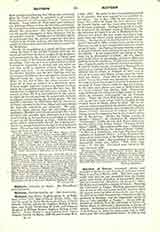

Matthew, SIR TOBIE, English priest, b. at Salisbury, October 3, 1577; died at Ghent, October 13, 1655. He was the son of Dr. Tobie Matthew, then Dean of Christ Church, Oxford, afterwards Anglican Bishop of Durham, and finally Archbishop of York, and Frances, daughter of William Barlow, Anglican Bishop of Chichester. Tobie Matthew matriculated from Christ Church, Oxford, March 13, 1589-90, and became M.A. July, 1597. He seems to have been harshly treated by his parents, who were angered at his youthful extravagance. On May 15, 1599, he was admitted at Gray’s Inn, where he began his close intimacy with Sir Francis Bacon, and two years later became M.P. for Newport, Cornwall. During this period of his life he frequented the dissolute court of Elizabeth. On the accession of James I he sat in Parliament for St. Alban’s, and joined the new court, receiving a large grant from the Crown which amply provided for his future. Having always desired to travel, he left England in November, 1604, visiting France on his way to Florence, though he had promised his father he would not go to Italy. At Florence he came into the society of several Catholics and ended by being received into the Church. A new persecution was raging in England, but he determined to return. He was imprisoned in the Fleet for six months, and every effort was made to shake his resolution. Finally he was allowed to leave England, and he travelled in Flanders and Spain. In 1614 he studied for the priesthood at Rome and was ordained by Cardinal Bellarmine (May 20). The king allowed him to return to England in 1617, and he stayed for a time with Bacon, whose essays he translated into Italian. From 1610 to 1622 he was again exiled, but on his return was favorably received by the king, and acted as an agent at court to promote the marriage of Prince Charles with the Spanish Infanta. In the same cause James sent him to Madrid and on his return knighted him, October 20, 1623. During the reign of Charles I he remained in high favor at court, Where he labored indefatigably for the Catholic cause. When the Civil War broke out in 1640 he, now an old man, took refuge with the English Jesuits at their house at Ghent, where he died. He was always an ardent supporter of the Jesuits, and, though it has long been denied that he was ever himself a Jesuit, papers recently discovered at Oulton Abbey show strong reason for supposing that he was in fact a member of the Society. Besides the Italian version of Bacon’s “Essays”, he translated St. Augustine’s “Confessions” (1620), the Life of St. Teresa written by herself (1623), and Father Arias’s “Treatise of Patience” (1650). His original works were: “A Relation of the death of Troilo Savelie, Baron of Rome” (1620); “A Missive of Consolation sent from Flanders to the Catholics of England (1647); “A True Historical Relation of the Conversion of Sir Tobie Matthews to the Holie Catholic Faith” (first published in 1904); some manuscript works (see Gillow, “Bibl. Dict. Eng. Cath.”, IV, 541-42). His letters were edited by Dr. John Donne in 1660.
EDWIN BURTON

